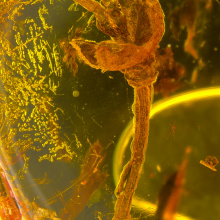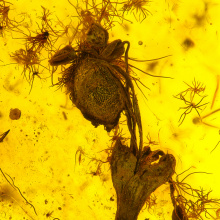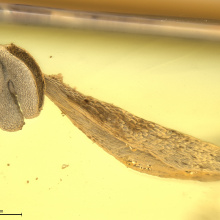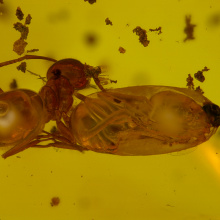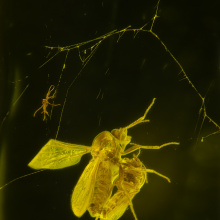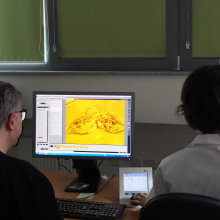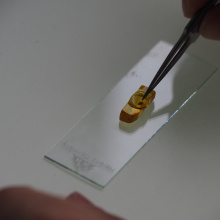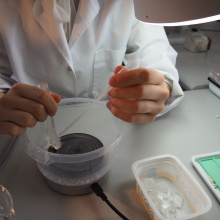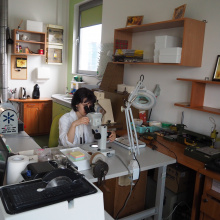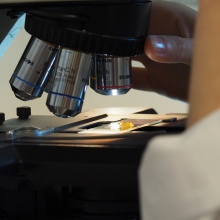Inclusion studies carried out in the fossil resin palaeontology laboratory of the UG Biology Department.
- Elżbieta Michalak-Witkowska: When I think of amber, two childhood memories automatically spring to mind: holidays by the sea from which we would bring back tiny ambers found in the sand and... the lyrics of a song in which amber was compared to 'a sunny drop of golden dreams'. Today I can take my son to the Museum of Amber Inclusion at the University of Gdańsk and show him all the millions of years locked in resin. When was the fascination with amber born, how did it happen that it is now the subject of scientists' research?
- Dr Elżbieta Sontag: In a museum in Norway we can see amber products discovered at archaeological sites from the Stone Age. Although I don't do archaeological research, I don't think it would be a big mistake to say that the fascination with amber came from the first person who found amber and noticed that it wasn't a stone! The Roman historian and writer, in the 1st century AD. Pliny the Elder, devoted an entire chapter to amber, in which he describes it, analyses the opinions of predecessors, and debunks myths. He counts it as a luxury item, but at the same time stresses that he does not know why amber is so popular. I didn't understand it either and I thought that a closed casket was the best place for it. Everything changed when I saw a fossil preserved in amber under a microscope.
In his work Meteorology (4th century BC) Aristotle pointed to animals found in amber as proof that amber was in liquid form. In 1783 based on a dragonfly preserved in amber a new species was described - one of the first to conform to the modern taxonomic system. So we can see that amber has always been studied by scientists, already some of the first scientific works described species based on inclusions. It is because of the jewellery treatment of amber that we often do not know about it. Additionally, it is worth mentioning that it was in Gdańsk that scientific publications describing new, extinct species of plants and animals preserved in amber were printed from 1830 until 1945. The Free City of Gdańsk had a rich collection of plant and animal inclusions gathered in the State Museum of Nature and Archaeology.
Dr Elżbieta Sontag from the Faculty of Biology of UG.
- In the lecture you recently gave at the University of Warsaw, you presented inclusions from a completely different perspective - as global natural heritage, thanks to which we can see and learn about the world 45 million years ago.
- The idea of viewing inclusions through the prism of heritage was born during one of the conferences of the Association of Academic Museums. At first, the topic seemed difficult to me, but after reading one sentence from the UNESCO Convention: 'include the most remarkable natural phenomena...' I knew this was it! As we look at the process of creating inclusions and their uniqueness and compare the criteria for inclusion on the UNESCO Convention World Heritage List, it is impossible not to find convergence. Additionally, its global character should be taken into account - amber, or more precisely fossilized resin, is known from all over the world. They were formed at various moments in the history of the Earth and documented the world at that time. Based on inclusions preserved in fossil resins we can learn about animals from the Triassic period (230 million years ago) up to the middle Miocene period (about 11 million years ago).
Dr Elżbieta Sontag from the Faculty of Biology of UG.
- You say amber and then fossil resin. Are they the same thing?
- Yes, amber is fossil resin, but I use amber in jewellery and when I go to the lab I work with fossil resin.
- You talked about the times when there was no Baltic Sea in the north, but the Amber Forests. Is that where the whole history began?
- Exactly, the beginning of Baltic amber is not the Baltic Sea, which is only 12 thousand years old. To get to know the genesis of amber we have to go back some 50 million years and look at a completely different arrangement of the continents. Far to the north, more or less in the area of modern Scandinavia, there was a huge land, which was overgrown by amber forests, forests - because it must be stressed that it was definitely not one ecosystem. The flora and fauna of these ecosystems are still being discovered, but one thing we know for sure - there were strongly resinous trees that gave rise to the fossil resin - Baltic amber.
Head of an ant embedded in resin. Photo: Collection of the Museum of Inclusion in Amber, University of Gdansk (MAIG).
- What can we find in amber? You argue that it is unique, three-dimensional fossils, showing unusual natural phenomena. Please give some concrete examples.
- Fossils preserved in fossil resins when viewed under a microscope look like modern microscopic slides. We can look at them from all sides, sometimes internal structures can also be seen (as in the head of an ant, which is in the photo attached below the text). Of course, not all inclusions have been preserved in perfect condition, sometimes they are only remains, which also represent important information. Through this precision of preservation, studying amber fossils, we learn not only about fauna and flora, but we learn about climate, we learn about evolution, ecological relationships, and even inter- and intra-species interactions. Mountain, cryophilic or tropical species, copulating flies, a predator with its prey, a mite using another arthropod as a means of transport, or fungi attacking insects are just a few examples.
- You mentioned the process of creating inclusions, so what was the path from an animal living in the forest 45 million years ago to a fossil in fossilized resin.
This path is not only very long but also difficult. Such an animal has to be in the forest, so it either lives in it or visits it, more precisely - in the vicinity of a resinous tree it has to fall into or be flooded by resin, but at the same time it cannot come out of it, nor can it be eaten - and being immobile it can be an attractive morsel. Once it has fallen in and not come out it must survive the process of fossilisation, i.e. becoming a fossil, and in addition, it must not destroy itself during the transport of resinous material. At the stage of amber forests and fossilisation, it is clear that the smaller the organism, the easier it could become a fossil. An amber trap could imprison anything, but its effectiveness was inversely proportional to the size of its prey. On the way to fossilisation, we have to remember about the second, modern stage - amber with inclusions has to be excavated, the inclusion has to be found, noticed and it has to be marked because 'something' in amber is nothing.
- Not all inclusions are visible to the naked eye. Some micro-inclusions are only visible with the help of a microscope. This is what you study in the paleontological laboratory of fossil resins, located at the Faculty of Biology of UG, right?
- And here we refer to the previous thread - only a small part of organisms submerged millions of years ago can be seen with the naked eye - only those quite large (above 2-3 mm). We have the advantage over other amber collections in Poland and also in the world that we usually study amber directly from the deposit and we are the first to look into it and we can see that the 'big' ones constitute only 10% of all the inclusions. With the development of microscopy and amber preparatory studies, we observe how this percentage of unnoticed inclusions increases significantly, but at the same time, another area of research is being discovered - microfossils in fossil resins. Noticing inclusions is the first stage, the second one is to label and interpret them well. This is where a multidisciplinary collective is most valuable. I hope that later this year you will be able to write about the extraordinary discovery that scientists from our Department have made together.
- Speaking of research, what role does the UG play in amber research? We have a laboratory, but we also have the Museum of Inclusions, which is open to all interested parties. We combine a scientific mission with a social mission, I guess?
- Leading. The scientific collection of inclusions was established at the University of Gdańsk in 1998 and in this way the pre-war tradition of creating a scientific collection of amber returned to Gdańsk. Today we have the best-equipped fossil resin palaeontological laboratory in Poland, and for 24 years we have been able to create a unique natural history collection that collects and makes available materials for palaeontological research based on fossil resins. We have 129 specimens in the collection, which are types (holotypes or paratypes) - the most valuable in natural history collections and are tucked safely away in a safe. Knowing the value, beauty and truth about amber we had to share it with others. And so a small, but unique exhibition 'Life in the Forest of Amber' was created, which is open to everyone. There are few places in the world where we can collect amber while walking on the beach; in most cases, the fossil resin is extracted using mining methods. We should notice and appreciate this. Gdańsk has been the 'World Amber Capital' since 1998 and the University of Gdańsk, both in Gdańsk and the Amber Capital at the same time, is a centre of reliable knowledge where you can look at amber from a different, biological perspective.
- At what times and when can you come to the WB to visit the Amber Inclusion Museum? Should we make an appointment in advance?
The Biology Department is open to everyone and every day, only on public holidays the building is closed. The most convenient times are between 8.00 a.m. and 6.00 p.m. Only groups of more than eight people should schedule an appointment via email in advance, as the small room where the exhibition is held cannot accommodate several groups. Of course, while you are at the Faculty of Biology, it is also worth visiting other exhibitions. We have a special mini-guide and we are still thinking about a better solution, but about that maybe some other time...
More about the collection of inclusions gathered by the WB
Exhibitions and mini-guide about the exhibitions at the Faculty of Biology UG

